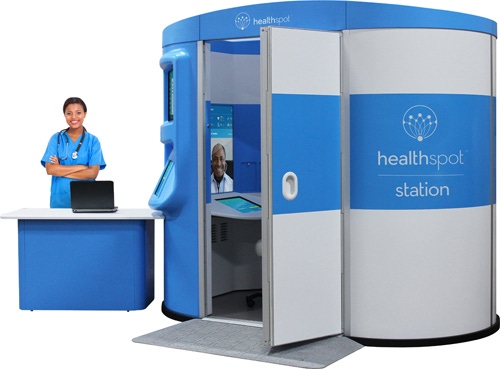Ohio Telehealth Startup Signs Up Mayo and Now Rite Aid
An Ohio digital telemedicine startup is teaming up with Rite Aid, Mayo Clinic and others in a bid to bring high-quality care to a retail setting.
November 7, 2014

Ohio telehealth startup HealthSpot has been going from strength to strength.
The company makes a standalone health kiosk by marrying three trends in the marketplace today – mhealth, retail medicine and telemedicine. In October, the company announced that Mayo Clinic has created the Mayo Clinic Health Connection and will be using its digital kiosk in a pilot program to treat its own employees in two locations in Minnesota.
And on Friday, HealthSpot announced that Rite Aid, the pharmacy chain, would use the HealthSpot station inside select Rite Aid locations in Ohio - in the Akron/Canton, Cleveland and Dayton/Springfield areas.
How does the HealthSpot station work?
The digital medical kiosk is stocked with 510-k cleared, interactive medical devices and video conferencing capability that falls under the definition of an FDA-approved medical device data system. The idea is that a patient, whether suffering a routine malady, or a more complex condition can walk into a HealthSpot station, and can video conference with a board certified physician or medical professional. Patients can use the digital medical devices such as a stethoscope or pulse oximeter and others to aid the professional in his or her diagnosis remotely.
In the case of Rite Aid, visitors using the HealthSpot station will be able to connect with a network of board certified medical professionals such as Cleveland Clinic and other major health systems across Ohio through the HealthSpot Network.
Aside from Mayo, this year HealthSpot has managed to score business partnerships with big names like Kaiser Permanente and Cleveland Clinic. HealthSpot stations are also available at Miami Children's Hospital and other unnamed health systems, according to Steve Cashman, CEO of the Dublin, Ohio company.
In an interview before the Rite Aid partnership was announced, Cashman said that the company's goal right from the get-go was to provide quality care.
"When we started the company, our goal was to create access for people who wanted the best doctors on the other end," he said.
And having the likes of Mayo, Cleveland Clinic and Kaiser Permanente is evidence that the goal is being fulfilled.
At Mayo, a soft launch of a pilot program, where about 2,000 Mayo employees in its Austin and Albert Lea locations can use HealthSpot to connect and receive care from Mayo doctors, nurse practitioners and physician assistants, has occurred. Mayo Clinic will start with one station but later expand to four.
Mayo hopes to extend the pilot program to employer locations in Minnesota so that employees can have access to Mayo's care remotely.
"HealthSpot is part of a larger telehealth initiative," said Dr. Matt Bernard, Southeast Minnesota region Primary Care Service Line chair, in a recent interview. "We are making a commitment to reducing healthcare expenses and looking at different ways to improve access to the medical services and this is a pilot to see how this technology will work to facilitate it."
Mayo providers can diagnose routine maladies - cold, earaches, sore throat, sinus infections, upper respiratory infections, rashes and skin conditions, and eye conditions - through HealthSpot.
What makes this pilot telemedicine program unique is that the HealthSpot data on Mayo employees will be connected to their individual electronic medical records. The success of the program will be judged on the basis of metrics including patient satisfaction surveys, how much volume of patients was seen through HealthSpot stations as opposed to having to see them at the clinic.
"Was the diagnosis accurate? Was the treatment good?" will be some of the questions that will be asked, Bernard said to judge the merits of the one-year pilot project.
The move to telemedicine and preventive care is part of a trend in healthcare driven by the broader move from the fee-for-service era to a fee-for-value era.
Technology is helping support the trend, but its use is still in its infancy.
"I think we haven’t come close to leveraging technology to not only to get people well but also to keep them healthy," Bernard says. "We need to do more in that regard.”
HealthSpot's Cashman will likely say "amen" to that.
[Photo Credit: HealthSpot]
-- By Arundhati Parmar, Senior Editor, MD+DI
[email protected]
You May Also Like


